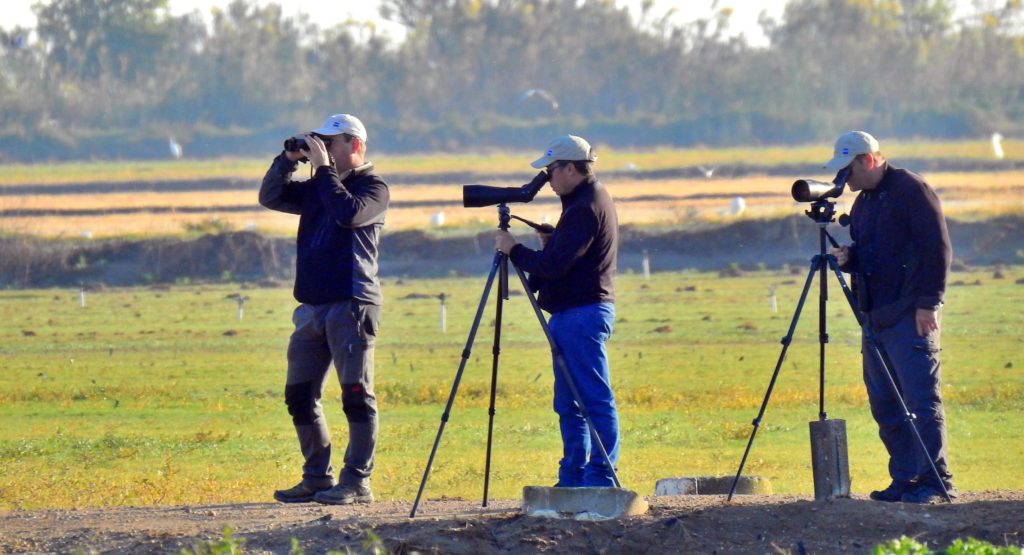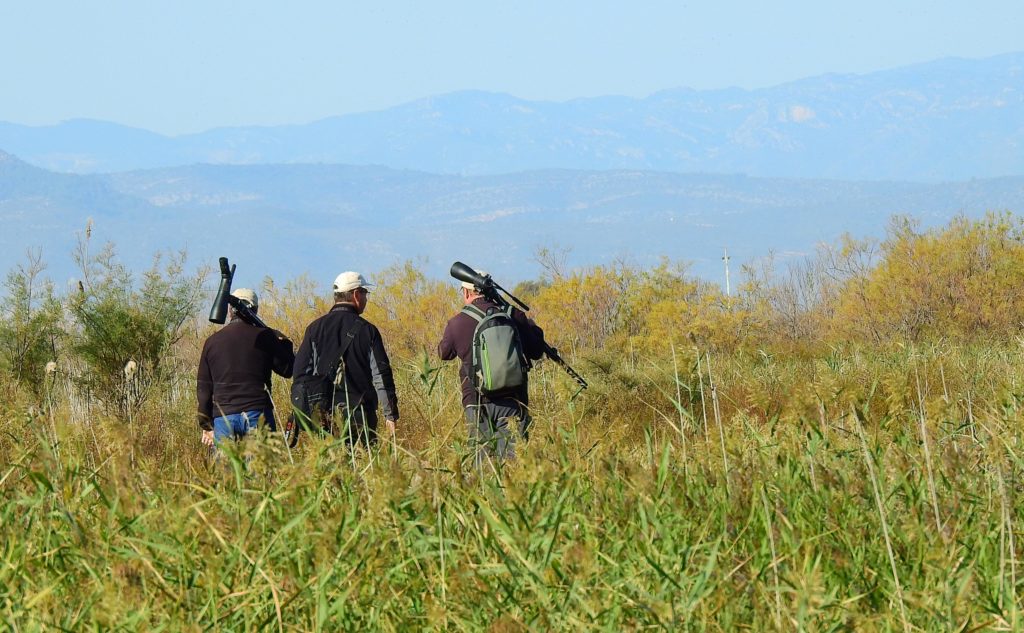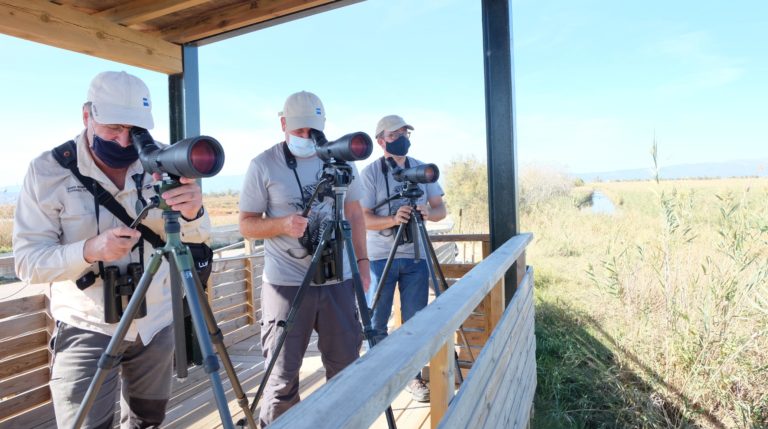The Spanish ornithologist José Luis Copete is known among insiders for his research on the Desert Owl and the description of Strix hadorami five years ago. Nowadays, birdwatchers of the Spanish-speaking countries appreciate mainly his podcasts on scientific discoveries in the world of birds. In our interview he talks about the regional dialects of birds, what distinguishes Finnish birdwatchers from Spanish ones and about his special bird observations in Barcelona at the time of the lockdown. Although he has been working as photographic editor for many years, he recommends the pure joy of birdwatching without an object lens. In addition, he reveals his favorite birding spots in Spain.
Tell us about yourself and the Team Reservoir Birds.
It all began when Stefan Riedl, who runs Excopesa, the distributor of Zeiss in Spain, asked some years ago to Francesc Kirchner for a birder in Spain with a good profile to be the face of Zeiss in the birding scene here. Francesc contacted me, and then I suggested to include in the team Ferran López and Dani López-Velasco. Ferran has been working monitoring birds in the Llobregat Delta reserves for more than 20 years and is the Spanish birder with the top list of WP species. Dani is very well known internationally because his role as a guide for Birdquest, traveling worldwide. We all three are respected birders in Spain -and we suppose that’s also the case away- and most important, very well known inside the Spanish community, because we have met with most of the birders in every corner. The name of the team comes from the website of birding news we manage, Reservoir Birds.
When did you start with birdwatching and what was the trigger/reason for it?
I began in the world of birds in 1981, when I was 12 years old. Actually my first interest were the herpetos, lizards and snakes. When I was a kid I spent countless hours moving stones to catch herpetos. My first guide was the classic book by Arnold & Ovenden about herpetos of Europe. However one day a contact from my mother made me to visit a ‘masia’ (the catalan name for farmhouse) in Tiana, a town not far from Badalona, near Barcelona, in the Serra de Marina, where he was going to ring birds. This sounded to me like sci-fi. I didn’t have an idea of what was the activity. That guy also had 12 years old, he went there with more older guys who were training younger people. On the very first day, going to the nets to release the birds trapped, and watching them in the hand, putting the rings, reading the Peterson bird guide, I was caught by this. I convinced my parents to buy my first bird guide on that year, and spent as many hours as possible in Tiana. So, I actually began as a ringer, not as a birder. The fact is on my very first years I didn’t understand some statements by birders coming to Tiana ringing station, like the difficulty to watch Garden Warbler on migration, when I knew it was so easy to ring the species in September putting a net next to a ficus. It was during 1983 when I discovered more properly what meant to be a birder, beginning to spend time only watching birds. To be honest, I’ve to admit that the first reason was to learn about birds in the hand, and secondly their songs/calls. From the beginning I was very interested to identify their voices, it was the reason to watch the birds in the forest in Tiana, to confirm the song/call belonged to the species I was supposing. The commonest were easy to tell apart. However when the migrants in spring and autumn I heard more voices, and watching the birds to confirm every sound was the main reason of my interest in watching them. At that time there was no internet, no xeno-canto, you needed to learn the sounds in the field. It was in my opinion a very good way to get interested in birds. Later on, when I had more birding friends, I combined both activities, and began to be more interested to watch birds as a pleasure.

What were your personal experiences of birdwatching during the Covid19 pandemic?
It was quite difficult, since my flat in Barcelona city is not offering special chances. I maintained a list of the species detected from my balcony when the strict confinement in March/April, arriving only to 38. However I’ve to say I saw some interesting species like Peregrine Falcon or Blue Rock Thrush, and by night I heard from my bed flamingos and Greylag Geese calling overflying the city. The absence of cars and noise by night helped to detect these flocks calling in the middle of the night. Apart of these experience during the strict confinement, the pandemic stopped all my plans of travels during 2020. In August it was supposed I’d to be in Colombia, however that trip was cancelled. So, when we had the opportunity to scape between the different levels of confinement we had in Spain, I focused more on local birding, like in Collserola hills surrounding Barcelona.
You tested the new ZEISS SF32 binoculars during the Global Bird Weekend. What were your favorite features of the product and what makes it special for you?
Two of the main features of the new ZEISS SF 32 impressed me: they are so light, that you can hold them wiht one hand without much effort; and the sharpness and luminosity. I knew before to test them they were x32, however I was really impressed by the level of light despite 1 cm less wide that the normal x42 I’ve been used to carry in the field. They are so light and sharp, that I don’t plan anymore to change my bins!! They are truly spectacular. They are simply stunning, the best binoculars I ever tested.
You are also interested in nature photography. Can you please tell us a bit more where your focus is and what would be the tips you would give to beginners of nature photography?
Well, I’ve to say that I would recommend to beginners rather than taking pictures all the time (something which is not bad in the end), to concentrate, when they begin, to watch birds. Nowadays there is a fashion to watch birds through cameras, especially since the mirrorless models are accessible because reasonable prices and not so heavy weight, to a lot of people. However I saw in the excursions and trips we guide for our company Icaro Birding Experience, that a lot of younger guys are only taking pictures with these models, to try to watch the image displayed on the screen. Most of the time they are not watching the bird but trying to get a picture to zoom in on the screen. That’s not the best way to learn about birds. My recommendation would be to watch birds with good bins, trying to focus on their behaviours, their movements, how they take food, etc…as well to try to learn all the voices they can listen. Later on, when you have more experience, getting inside the photography.
What is your most exciting motif of mammal photography (which mammal)?
That’s easy to answer. My most desired mammal to be seen in the wild was Snow Leopard. Because it’s so difficult to be found, as well as because it lives in remote areas, normally on rugged terrain, which is adding a component of mystic to their figure. So, when I saw it for first time in Ladakh in 2015, together with one of our team members at that moment, Dani, it was one of my best moments in the field.
I worked as photography editor for the Handbook of the Mammals of the World on the entire series, where I had to check more than 350.000 pictures of mammals. So, after 10 years of checking and selecting pictures of mammals (not to mention how many I had to do for the same role on the HBW dealing with bird pictures), I can say I got some experience to know which mammals has been well photographed and which others are not. Snow leopard images improved a lot during the last five years, after some photographic trips for the species began to be operated. Fortunately, we did our trip away of the crowd, in a place where no people was present and where we stayed alone for ten days, without other photographers or tourists. It was a very nice experience, spending days on the mountains trying to discover the Snow Leopard on the ridges by ourselves.

Which would be THE recommended birding destination in Spain and which birds are expected to see there?
It’s difficult to mention only a place. I would mention some very different places which are on top of what I would recommend to foreigners coming to Spain. One is the steppic area near Belchite, in spring, when you can watch flocks of sandgrouses, listening Dupont’s, Calandra, Lesser Short-toed and Short-toed Larks as a dawn chorus, Stone Curlews, and watching some raptors like Black Kite, Golden Eagle and others, apart of the many migrants like warblers, wheatears, chats, and many others. Another place to recommend is Estaca de Bares in autumn, combined with some seawatching by boat. Spending a few days there in September/October offers the most impressive seawatching migration in Europe, with thousands of shearwaters, terns, alcids, skuas, and manhy other seabirds, sometimes quite close from the cap, from a panoramic view over the sea which is unparalleled. Finally, because is one of the places where I stay more regularly, I would also recommend the Ebro delta, for a few days in April/May. Waders, ducks, gulls, terns, passerines breeding on reedbeds and wetlands, seabirds, and on migration waves, birds everywhere, and the rarities always possible at every moment.
You have been travelling a lot in the past years. Did you recognize any “regional” dialects of birds and do you recognize your local birds by their sounds?
Many times is difficult to know when is the boundary between individual variation and dialect. However in some species this is not especially difficult, as happens with the Ortolan Bunting. I spent several years working on a research project on the species, in La Segarra county, Catalonia, from 2013 to 2018. The local dialect of the species there is different from that you can listen in central and north Europe. Not only that: when you try to use playback with recordings of central Europe to our local birds, their reaction is not really straight. Very different when you use playback of the song you recorded of the birds breeding in the area: the reaction is straight, very aggressive. They of course identify those playbacks as true competitors. Not the same when they listen Ortolan Bunting song from Germany!
Have you recognized any differences between the ornithologists in other countries?
What I saw is more related to social and cultural differences. People in Spain is quite heterogenous, as corresponds with a society with different languages, ways of life, different cultures and traditions. However, I noticed that birders in Finland, which I consider they are one of the best birders in the world as a community, they are quite similar in the way they go to the field, carrying many of them the finstick, rubber boots, similar dressing, etc… and they have a good school of birding, is normal there to meet people you doesn’t know the name who are very good in the field. That’s is quite different in Spain, where there are quite a lot of different birding levels, different dressings, since is not the same being in the field in Galicia, the northwest corner where rains a lot, that being in the field in Andalucia, quite hot and a more Mediterranean landscape. We are also more noisy people, Spanish birders talk a lot when they are relaxed. Away of Spain I found people to be more silent. That’s something easy to detect.

When you think of nature conservation, which species do you personally have in mind to put a focus on?
Rather than a species, I think more on a community of species related to a specific environment: the birds breeding in agricultural fields. A lot of species depend on this, and many of them suffered heavy declines. Species like Ortolan Bunting, the flag of the recent European breeding bird atlas, is a good example, since it suffered a big contraction of the range. It’s because the intensification of the agriculture, which is removing the scrubs between fields, the small plants on the boundaries, the fallow fields… I began ot have an age to remember when some species were very common in cultivated fields, but nowadays you feel they are not anymore like in former times, as happens with the Quail. It also apply to the steppic species breeding in open cereal fields, like Calandra Lark, Little Bustard, Stone Curlew, Pin-tailed and Black-bellied Sandgrouses in fallow fields. Is very urgent to reverse this trend.
Tell us more about the podcasts and what is your personal motivation to invest time in this project?
We began La Radio del Somormujo (https://laradiodelsomormujo.com/) in 2018. There were no other podcasts about birds, directed to ornithologists and nature lovers, in Spain. So, there was space to try that project. We discovered it was very well received. And the community of somormujers grew up quickly!! I feel it’s very important to spread the scientific discoveries to the people interested on birds as amateurs. Many of them are not aware of what’s discovered. Divulgation of scientific research, and conservation projects, is one of the most rewarding works you can done since you are helping to promote a culture for conservation of birds. We are arriving to people already being birders, as well as to people just interested in nature, however also to people who is not yet interested as we are. Our aim is to talk about birds in a kind way, explaining anecdotes, introducing some times some humour, to get the people connected. When you talk about science in a very academic way, many people are not interested because you appear distant. You need to get in touch. And the way is to make the communication close to the audience, not trying to sound too much scholastic. We are very proud our message is arriving to more people. Our podcast was chosen this spring as one of the more interesting science podcasts more at the main podcast platform in Spain, iVoox, so an initiative purely altruistic is every time arriving more far away. Thanks to our podcast I participated a few times on some important radio programs in Spain, like A vivir que son días, where I could spread the message about birds. And we have been doing the program by free, every week, getting close to podcast number 100. In January we will arrive to that landmark! The number of people following our podcasts is remarkable, we get over 40.000 downloads. We just expect we can set the structure when we find some sponsor who can help, since it demands quite a lot of time to prepare the program every week, non-stop.
Who wants to listen to the lively and well explained podcasts, chooses one of the programs on https://laradiodelsomormujo.com. It is worth to learn some Spanish for this. Also, with basic Spanish knowledge it is possible to follow. More information about the ZEISS SF32, which José Luis tested, you find here: www.zeiss.com/morediscoveries
About Post Author
Visits on this Page:3894